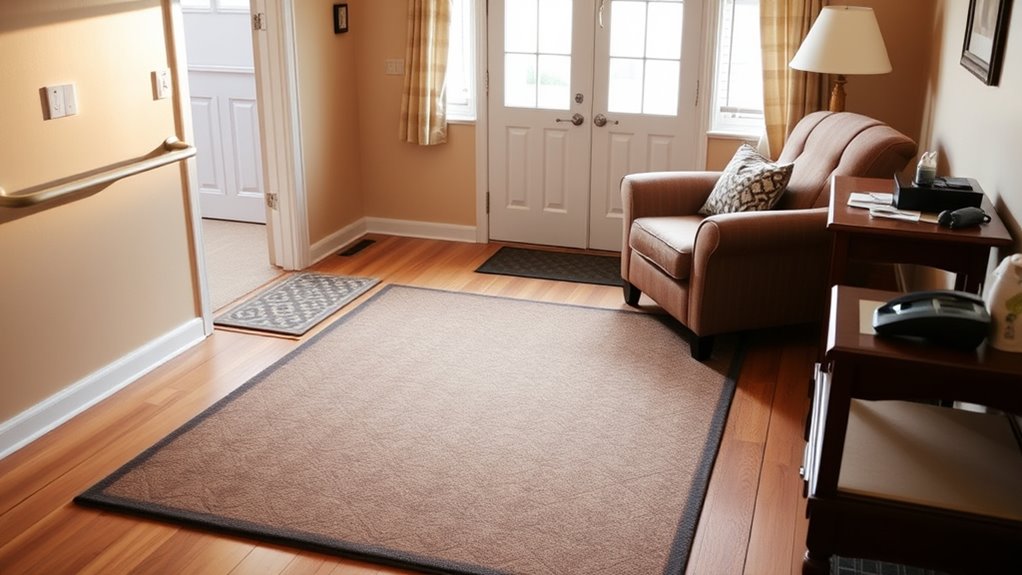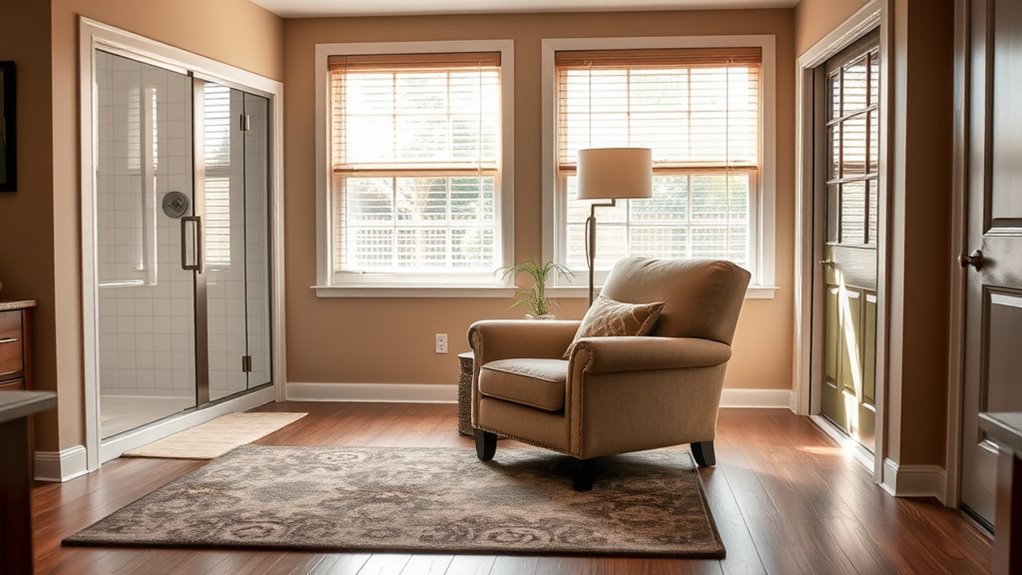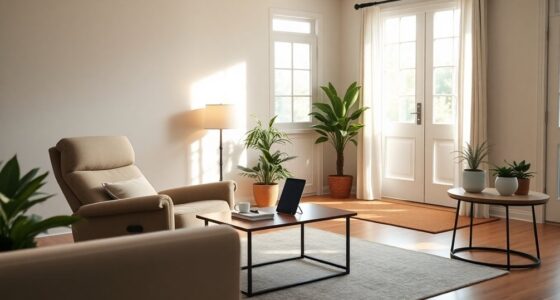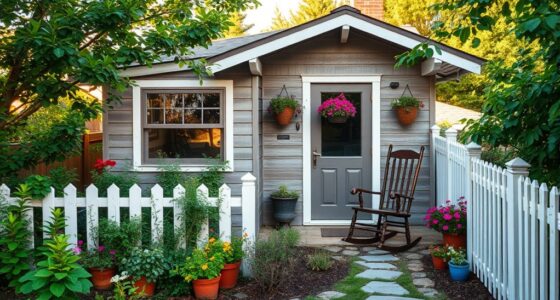To age comfortably at home, focus on simple upgrades like adding motion-activated lighting, installing grab bars in bathrooms, and using non-slip mats to prevent falls. Consider smart devices that monitor safety and help you stay connected. Ergonomic furniture and mobility aids improve comfort and confidence, while stair lifts or ramps make shifts easier. Small changes create a safer, more accessible environment—keep exploring these options to make your home truly supportive for your needs.
Key Takeaways
- Install motion-activated lighting in hallways and bathrooms to improve visibility and prevent falls.
- Add grab bars near toilets and in showers for extra support and safety.
- Use non-slip mats in bathrooms and on staircases to reduce slip hazards.
- Incorporate smart home devices like voice assistants to control lighting and appliances easily.
- Replace traditional furniture with ergonomic options to enhance comfort and reduce strain.

As we age, making simple adjustments around the home can considerably enhance safety and independence. You want your space to support your lifestyle, not hinder it, and small changes can make a big difference. One of the easiest ways to improve your living environment is by integrating smart technology. These devices can help you stay connected, monitor your safety, and even automate daily tasks. For example, voice-activated assistants allow you to control lights, thermostats, and even ask for help without moving from your seat. Smart sensors can alert you if a door is left open or if there’s unusual activity, giving you peace of mind. Installing smart technology isn’t just about convenience; it’s about creating a safer, more responsive environment that adapts to your needs. Smart home devices can also be customized to fit your unique preferences and routines, further enhancing your independence. Mobility aids are another essential upgrade for aging in place. Whether it’s a sturdy walker, a cane, or grab bars in the bathroom, these aids provide stability and confidence as you move around your home. You might find that adding a stair lift or installing a ramp at the entrance makes daily transitions easier and safer. When choosing mobility aids, focus on comfort and practicality—look for adjustable features and ergonomic designs. Proper placement of these aids around your home ensures they’re always within reach when needed. For example, placing a grab bar near the toilet or in the shower can prevent falls, making routine tasks safer. You should also consider ergonomic furniture that reduces strain on joints and muscles, further supporting your independence. Combining smart technology with mobility aids creates a comprehensive safety network in your home. For instance, sensors can alert you if you attempt to climb stairs unsafely, or if you need assistance getting up from a chair. These interconnected systems can be integrated into a smart home setup, providing real-time feedback and support. When planning your upgrades, prioritize lighting, reducing trip hazards with nightlights or motion-activated lamps, especially in hallways and bathrooms. Non-slip mats and rounded furniture edges also contribute to a safer environment. Remember, the goal is to make your home more manageable without making it feel institutional. Small, thoughtful adjustments ensure that your space remains comfortable, functional, and safe as you age. Ultimately, embracing smart technology and mobility aids empowers you to maintain your independence longer. These upgrades are investments in your safety and quality of life. With a few simple adjustments, your home can adapt to your evolving needs, letting you enjoy your space comfortably and securely for years to come.
Frequently Asked Questions
What Grants or Financial Assistance Are Available for Aging-In-Place Home Modifications?
You can access various financial assistance programs designed for aging-in-place modifications. To get started, research grants like the USDA’s Single Family Housing Repair Loans & Grants or local programs. When applying, follow grant application tips such as providing detailed documentation and clear project descriptions. These programs aim to help you fund essential upgrades, making your home safer and more accessible without straining your finances.
How Can I Assess My Home’S Safety for Senior Living?
Imagine you’re a lighthouse keeper, constantly scanning for hazards. To assess your home’s safety for senior living, start with a thorough risk assessment. Check for trip hazards like loose rugs, guarantee adequate lighting, and install grab bars near bathrooms. Walk through each room, looking for potential dangers. This proactive approach helps you identify issues early, making your home safer and more comfortable for aging in place.
What Are the Best Low-Cost Upgrades for Elderly Accessibility?
You can improve accessibility with low-cost upgrades like adding non-slip rugs and installing grab bars in key areas. Focus on staircase safety by adding sturdy handrails and ensuring good lighting. For bathrooms, consider simple modifications like raised toilet seats and grab bars near the shower and toilet. These affordable changes make your home safer and more comfortable, helping seniors move around confidently and reducing fall risks.
How Do I Choose the Right Contractor for Home Modifications?
Choosing a contractor is like planting a sturdy tree; you want someone reliable. Look for contractor qualifications that match your project needs, guaranteeing they have experience with home modifications for seniors. Ask for references and review past work. Discuss the project timeline to ensure they can meet your schedule. Trust your instincts and communicate clearly—these steps will help you pick the right contractor for safe, successful upgrades.
Are There Any Legal Considerations When Modifying a Home for Seniors?
When modifying a home for seniors, you should be aware of liability concerns and permit requirements. It’s important to guarantee your contractor follows local building codes to avoid legal issues and potential liabilities. Check if permits are necessary for the upgrades, like ramps or bathroom modifications, and obtain them beforehand. This not only keeps your project legal but also protects you from future disputes or safety concerns.
Conclusion
Just as a sturdy ship relies on its strongest anchors, your home should support your independence and safety. These simple upgrades are your safeguard, helping you age gracefully and comfortably, much like the timeless wisdom of a well-loved story. By making these easy changes today, you’re ensuring a secure haven where you can continue to thrive—your own castle, resilient and full of life, just like the heroes of old who faced challenges with courage and grace.









